All the best spots in the Perth Hills to go wildflower spotting this spring.
In true Perth style, there has been no lack of sunshine and 24+ degree days lately. Just like the gorgeous weather, the wildflowers in the Perth hills made an early appearance too. Blooming since early August, the wildflowers are ready and waiting to be discovered by the enthusiastic wildflower fan.
Fancy doing a bit of wildflower spotting yourself?
These are the best spots to spy some native colour in the Perth hills during wildflower season.
1. Mundy Regional Park
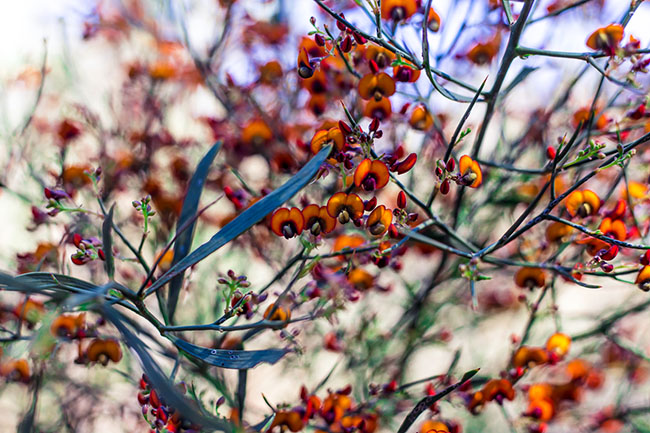
Mundy Regional Park borders the suburbs of Forrestdale and Kalamunda, a short, 25-minute drive from the city. The park has a sizeable number of walking trails, loved by the Perth community for their panoramic views over Perth, the climbable granite outcrops, and the stunning display that the wildflowers put on in the spring. The park is also dog friendly, so you don’t need to leave your furry friend at home (just keep him or her on a lead).
On your way out to Mundy Regional Park, pop the Lesmurdie Falls bottom car park, or the Lewis Rd car park, into your maps. If you don’t, you’ll end up on the edge of the park, with nowhere to pull up. The Lewis Road car park entrance mightn’t have the falls, but there’s a bubbling creek that runs just to the left of the track, and plenty of gorgeous yellow-eyed flame peas, purple and yellow flags, and orchids to feast your eyes on.
2. Ellis Brook Valley Reserve
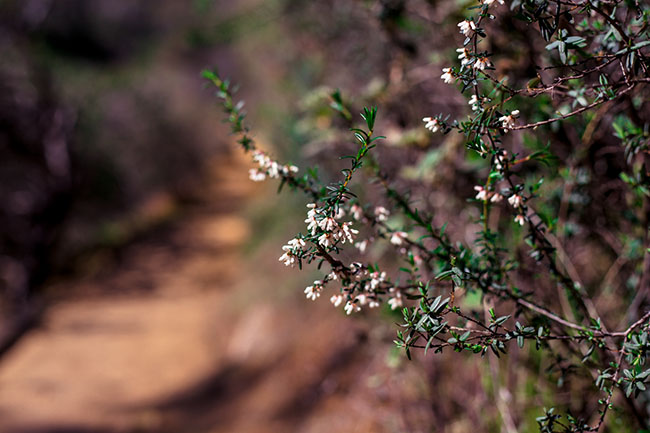
Nothing pairs more perfectly with an afternoon of wildflower spotting than a bit of dog petting. Trust us, we’ve tried it. Ellis Brook Valley reserve is full of diligent dog parents taking their good boys out for a wander, and of course, wildflowers too.
Located on Rushton Road in Martin (just outside of Gosnells town centre), Ellis Brook Valley is one of the most wildflower rich spots in Perth, with over 500 species across the reserve. All the usual suspects are there – wattle and helichrysum macranthum, for example – as well as a gorgeous array of starflowers, trigger plants and orchids. Before you hit the trails, there’s a great information centre to help you identify the wildflowers that you spot along the way.
There are four different walk trails in the reserve, including the easy ‘easy walk trail’, and the picturesque ‘Sixty Foot Falls’ circuit, which takes you up to the very top of a waterfall. From the top, you can spot the teeny skyline of Perth city, and see all the way out to the coastline.
3. Armadale Settlers Common
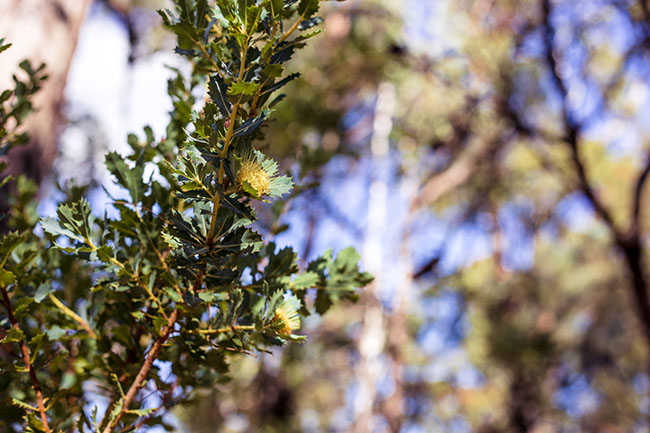
Head 10 minutes out of central Armadale, and you’ll hit Settlers Common on the Darling Scarp. The 383 hectare reserve is home to some 318 different plant species, many of which only come out to play over the wildflower season.
Come spring, Settlers Common is awash with colour. The big, blooming bushes of golden wattle are hard to miss, but spotting some of the other common wildflowers in the area requires a keen eye. Hiding amongst the underbrush, you can spot delicate little cowlip and spider orchids, and everyone’s favourite native, the kangaroo paw.
Settlers Common is a very easily accessible reserve. You can get to it from multiple car parks along Canns Rd, but the car park on Observation Circle is a favourite for its views out over Perth, and through to the ocean beyond. The wide paved walking tracks add to the reserve’s accessibility, allowing wheelchairs and prams to easily navigate the bushland. There are picnic areas dotted along the tracks too, perfect for a little rest and refuel.
Post wildflower walk, call in to Rocksgate Winery (open Sunday’s 12-5pm) or The Last Drop Elizabethan pub (open daily) around the corner for a well-deserved tipple.
4. Bungendore Park
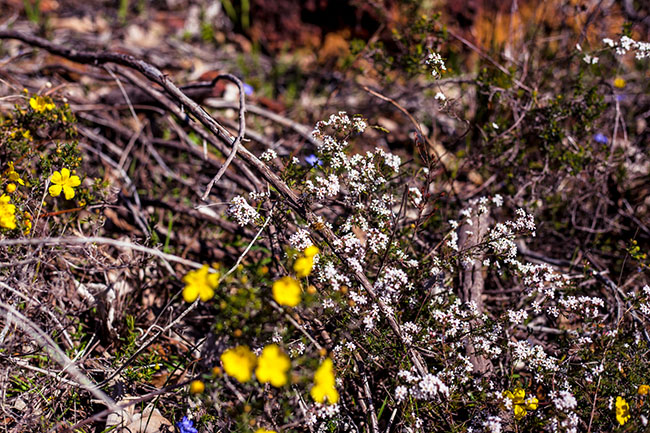
Armadale has no shortage of impressive national parks nearby. The 498 hectare Bungendore Park is just another one of the parks within a 10 minute radius from town.
You can access the park from its main entrance at Admiral rd in Bedfordale, or from Dyandra loop off Albany Highway (this entrance sneaks up on you, so be prepared to stop well in advance).
This huge park has four different walking tracks you can take, marked out by tree tags. Along the walk, you will tramp through mostly jarrah and marri forest, wander by freshwater creeks, climb a few granite outcrops, and, in spring, spy plenty of wildflowers. Expect to spot anything from the blue lechenaultia and bull banksia, to bird orchids, yellow-eyed flame peas, and beaufortia macrostemin.
5. Serpentine National Park
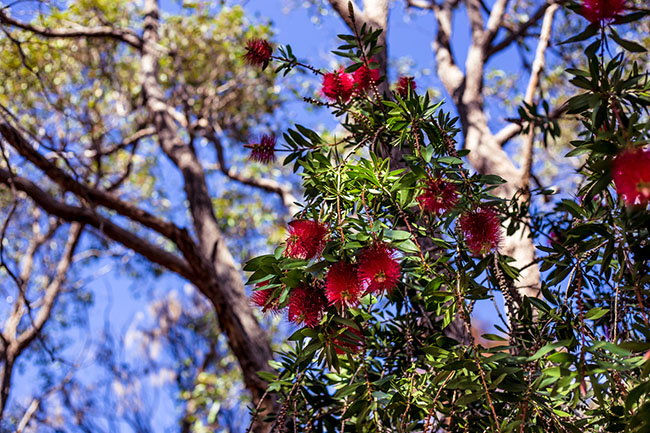
It’s a bit of a Perth-anality for its falls, but there’s more than one reason to pay Serpentine Falls a visit this spring. This huge national park, 50km to Perth’s south east, is also home to a dam, the Serpentine River, pretty picnic spots, and an abundance of seasonal wildflowers.
Before getting to Serpentine National Park’s walking trails or the falls, each car coming into the park must purchase a $13.00 day pass ($7.00 for valid concession card holders). Once in the park, you can head straight to the falls, or head to the Serpentine River to go on a wildflower hunt. In spring, the walk is lined with natives like wattle, kangaroo paws, hakea, orchids and verticordia.
The park gets particularly busy on weekends and warm days and closes once it reaches capacity. We recommend arriving before 10am to avoid disappointment.
If you save your trip to Serpentine for a warmer day, you can finish your hike with a refreshing dip in the falls pool. Before you leave the area, call in to the Hugh Manning Tractor and Machinery Museum, and grab a bite for the road at the Rusty Nut Cafe.
Keen to learn more about WA’s wildflowers this spring
Join the Wildflower Society of WA’s Armadale Branch for their Spring into Armadale guided walks;
Sunday 15th September – 8:30 am: Lloyd Hughes Reserve
Meet: Marmion St, Kelmscott. Leader: Friends of Lloyd Hughes, Anne Baird, Barry Combs.
Lloyd Hughes park is a 17.7-hectare A class reserve in the foothills of the Darling Scarp at Kelmscott and managed by the City of Armadale. The Park is bounded by Martin St., Marmion St., Canning Mills Rd, and abuts Banyowla Regional Park to the north. The Park straddles the boundary between the Ridge Hill Shelf and the Darling Scarp soil types. The main vegetation types within the Park comprise Marri and Jarrah woodland, and Flooded Gum woodland along the creek-line. In earlier times, areas within the Park were mined for gold and slate.
Saturday 28th September – 11:00am Bungendore Park
Meet: Bedfordale Bush Market (Wildflower Society stand), Admiral Road, Bedfordale. Leader: Wildflower Society Member. Consisting of 498 hectares, Bungendore Park is located on the edge of the Darling Scarp approximately 30 km southeast of Perth and approximately 5 km south of central Armadale. It is part of the Wungong Regional Park.
Sunday 13th October – 8:30am Fletcher Park & Lambert Lane Reserves
Meet: End of Lambert Lane, Wungong Leader: Kim Fletcher.
Fletcher Park and Lambert Lane form part of Bush Forever Site 264 (approx 19 ha). The vegetation has been listed as ‘Critically Endangered Threatened Ecological Community’ of Corymbia calohphylla, Kingia Australia woodlands on heavy soils. Most of the site is in excellent condition. The site is known to contain 105 native flora species, of which two species are Declared Rare Flora – Eucalyptus balanites and Diuris purdiei. Fletcher Park contains Conservation Category, Resource Enhancement and Multiple Use Wetlands. A seasonal stream flows along the north eastern boundary of Fletcher Park.
Saturday 2nd November – 8:00am Connell Avenue Reserve
Meet: End of Cockram Rd, Kelmscott. Leader: Narelle Mewburn.
Connell Avenue Reserve (Bush Forever Site 061) is located at the western section of the Banyowla Regional Park. The flora is typical of Ridge Hill Shelf vegetation, the area where Swan Coastal Plain and Darling Scarp flora meet. A significant species in this reserve is Jarrah Eucalyptus marginata ssp. Elegantella.
Saturday 23rd November – 11:00am Bungendore Park
Meet: Bedfordale Bush Market (Wildflower Society Stand), Admiral Road, Bedfordale. Leader: Wildflower Society Member Consisting of 498 hectares, it is located on the edge of the Darling Scarp approximately 30 km southeast of Perth and approximately 5 km south of central Armadale. It is part of the Wungong Regional Park.
For more information visit wildflowersocietywa.org.au.
Sponsored Content: This is a sponsored post for Perth Hills Armadale Visitor Guide Campaign – by the City of Armadale – endorsed by So Perth. We value your feedback so please contact us with any questions on our sponsored post. Thank you for supporting So Perth and our local partners.






